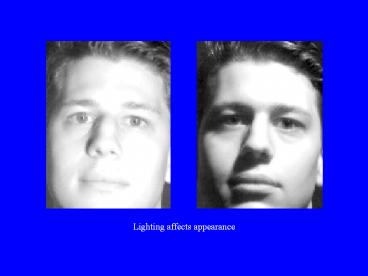Lighting affects appearance PowerPoint PPT Presentation
1 / 24
Title: Lighting affects appearance
1
Lighting affects appearance
2
(No Transcript)
3
4
Light
Source emits photons
And then some reach the eye/camera.
Photons travel in a straight line
- When they hit an object they
- bounce off in a new direction
- or are absorbed
- (exceptions later).
5
Reflectance
- Model how objects reflect light.
- Model light sources
- Algorithms for computing
- Shading computing intensities within polygons
- Determine what light strikes what surfaces.
6
Basic fact Light is linear
- Double intensity of sources, double photons
reaching eye. - Turn on two lights, and photons reaching eye are
same as sum of number when each light is on
separately. - This means we can render lights separately
7
Light Model Point Source
- Light emanates from a point
- Equal intensity in all directions
8
- Intensity drops off with distance.
- With square of distance
- To simulate effects of non-point sources
9
Light model distant point source
- All light in scene comes from same direction.
- With same intensity
10
Surfaces reflect light Lambertian
- Amount of light striking surface proportional to
cos q - Angle between light direction and surface.
- Equal brightness in all directions
- Albedo is fraction of light reflected.
- Diffuse objects (chalk, cloth, matte paint).
- Brightness doesnt depend on viewpoint.
Surface normal
Light
q
11
Lambertian Point Source
Surface normal
Light
q
12
Lambertian Examples
Lambertian sphere as the light moves. (Steve
Seitz)
Scene (Oren and Nayar)
13
Ambient
- Assume Lambertian surface normal receives equal
light from all directions. - Diffuse lighting, no cast shadows.
- Ambient (and point) light can be colored
14
Ambient Point Source
- Needed to avoid artifacts
- Make sure shadows arent black.
- Reasonable approximation to general
- Sun sky.
- Lamp light reflected by walls
- In fact, its a 1st order approximation.
- But doesnt handle many effects
- Sources of other shapes.
- Shadows of ambient light in concave objects.
15
Shadow example
16
Specular surfaces
- Another important class of surfaces is specular,
or mirror-like. - radiation arriving along a direction leaves along
the specular direction - reflect about normal
- some fraction is absorbed, some reflected
(http//graphics.cs.ucdavis.edu/GraphicsNotes/Shad
ing/Shading.html)
17
Specular Direction
18
Specular surfaces
- Brightness depends on viewing direction.
- Specularity is spread out.
- Mirror, smooth light all bounces same way.
- Slightly rougher, direction of bounce varies.
- Diffuse, many bounces
(http//graphics.cs.ucdavis.edu/GraphicsNotes/Shad
ing/Shading.html)
19
Phongs model
- Empirical model (eg., hack)
- Phongs model
- reflected energy falls off as
- n very big, this is like mirror.
- As n gets smaller, specularity more spread out.
- Good model for plastic
- Specularity color of source.
(Forsyth Ponce)
20
Lambertian specular
- Two parameters how shiny, what kind of shiny.
- Many objects combine shiny and diffuse material
- Wood with veneer glossy paint, plastic, greasy
skin.
21
LambertianSpecularAmbient
(http//graphics.cs.ucdavis.edu/GraphicsNotes/Shad
ing/Shading.html)
22
More complex reflectances
- Physically realistic models
- Torrance Sparrow models roughness of surfaces and
shadowing of microfacets. - Models built from observation.
- Measurement for every lighting direction and
viewing direction.
23
BRDF Not Always Appropriate
BRDF
BSSRDF
http//graphics.stanford.edu/papers/bssrdf/
(Jensen, Marschner, Levoy, Hanrahan)
24
Luminescence
- Surface shifts color of light.
- Can reflect more light of a color than is present
in source. - This is why objects can glow in black light.

